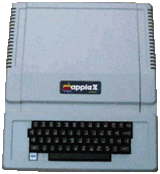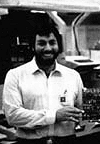 |
| Nach Hause | Roll: botic | ghack | juortner | p3k | Inactive: catfish | girlsCamp | ribbonfarm |
StefanL, 27.08.01, 19:24
|
|||||||||||||||||||||||||||||||||||||||||||||||||||||||||||||
The 4th Bubble starts by looking back in personal computing history. Looking back is not a goal on its own but a way of connecting snippets into a meaningful chain. The meaningful chain allows for the right conclusions && for the right actions. So on we go:
As you can easily derive from the history of personal computing Steve Wozniak designed the Apple II as an open personal affordable not networkable computer and published the Apple II Reference Manual that contained specs of the memory layout, described how to add hardware and peripherals etc.
At the time when business need and other influences started to kill the concept at Apple (1980) Don Estridge of IBM started to lead their PC Division and together with a dirty dozen of design and manufacturing engineers copied Steve's concept in most every detail, switched from MOS Technology to INTEL thereby saving the idea of open affordable personal computing, surely something IBM had not envisioned. GOOD can come from the BAD! After his death in '85 IBM went back to their old ways, started PS/2 - OS/2.
In the same way Apple went on to develop the LISA and the MAC, closed down on information and tried to bind SW closely to propietary HW, a concept all Manufacturers except maybe MITS with their DIY product Altair had followed before Woz.
Both of these counterreformations never found any remedy against the somehow more open concept of the so-called "industry standard PC architecture". So gradually but slowly the leadership in the development of micro and other computers drifted over to the two most decided and competent supporters and beneficiary of that architecture, Intel and Microsoft.

In the meantime a group of people at office copier machine dominator XEROX's PaloAltoResearchCenter started to really build a machine in SW the instructions of which didn't look like
LDA CC1A ADD #00FE STA CC1C
anymore. They called those constructs a virtual machine. These virtual machines could and should be implemented on different kinds of hardware but in reality they executed on personal computers like the Alto, the Dolphin and the Dorado. Nobody could afford those fancy machines, practically everybody in IT used a TTY then. The Sun-1 workstation appeared in 1982, 5 years after the Apple II and 1 year after the IBM PC. Even a workstation like the sun could barely run and not really run a Smalltalk Virtual Machine. It took many years to have the kind of virtual machine an Alto could drive run on a personally affordable computer.
The PARC people were not the only ones to think about and develop with virtual machines. One's gotta mention the UCSD P-System that you could install on the original PC with the benefit of having Pascal instead of Basic. Behind that compiler was an OS come virtual machine. And what's also gotta be added, is, that from at least the point on when the Bell labs people rewrote Unix in C, the Unix kernel has become a virtual machine, the model of which in the meantime has grown to be the most pervasive of all VMs.

reminds me to an interview with ted nelson. in his thinking, wozniak was satan himself . in his opinion, the nerdy one of both steve's killed the creative computing culture by introducing the "certified developer". i would prefer the "satan's right hand", putting in the role of the other steve.
by the way: has anybody seen a "break out" online game (java or flash prefered)?
p.s.: ted nelsons mental state is another story
... plink
bubbles...
... still haven't a clue about your meaning of bubble, hope that it has nothing to do with sloterdijks "Blasen" giggle
... plink
Don't be so literal and logical
it's just a word. If you missed one than check out what inspired me. it's just a story.
Nelson is a sour idiot. I'd trade the god scientist against the satanic certified developer any old day. Besides after 24 years the most important work - in SW at least - is still done by uncertified developers and amateur inventors.
... plink
assemble!
last time i have seen somthing with "lda" or "sta" was, when i was visiting jugendzentrum marco polo, centuries ago
... plink
... answer!
someone
who came to the same conclusion as you, regarding history, is dan bricklin. at least he is stressing the same points as far as i am concerned. but still no answer why it had to be that way and why it succeeded.
... plink
Dan Bricklin
Was in part 1 first but then i decided to come up with the SW people later after i had added all the links and a reasonable history timeline. More about him to come up soon.
... plink
... answer!
still searching
why intel made the deal. looking throught this list there have been a lot of choices around. another one was asking the same question, telling the story "that IBM's own engineers wanted to use the 68000, and it was used later in the forgotten IBM Instruments 9000 Laboratory Computer" but there was something they called bubble memory involved ?? ...
... plink
Spreadsheet Reparations
A friend of mine, Dan LaLiberte, of EMACS Lisp manual fame (um, and I) suggested about ten years ago that Bricklen and Kapor should be required to fund a Neo-Nobel like prize for software. Nobel is said to have endowed his prizes to atone for the harm sure to be done to humanity as a result of his invention of dynamite. The rationale for a spreadsheet zillionaire prize for software would be that by enabling otherwise harmless MBAs to "crunch numbers" and launch the plague of hostile take-overs and downsizing and looting we've seen since the '80s, they'd done as much harm to humanity as Nobel ever did...
--BF, only partially in jest...
... plink
Intel and IBM
Actually it might just have been the climate of the negotiation that brought the deal to Intel. Availability (large quantity delivery of peripheral chips)and affordability (large quantity pricing) might have been big factors. The Great Dark Cloud Falls [In around] mentions that Gary Kildall, author and owner of CP/M which for shure was the first OS of choice was not happy about IBM's terms. Also remember that UCSD-P, CPM/86 and very soon after MS Xenix where offered as an OS. I think they were all more expensive and had programming environments that were better but less accessible (?) for the beginner and amateur than the built in MS Basic.
I agree on Bricklin and Kapor. I even think the harm they did was more intricate. On the other hand, like Bill they really helped to ambivalently weaken the hold IBM had before UsableAffordablePersonalComputingDevices.
... plink
... answer!

Business and Economy
Cloud Appreciation
Media Ecology
Movies and Music
Glossaries and Grammars
Great Jewish Songs
Obituaries
People in Information Science
Political Science
... all tiny topics

Terms of Service
About us / Imprint
| Dezember 2025 | ||||||
|---|---|---|---|---|---|---|
| So. | Mo. | Di. | Mi. | Do. | Fr. | Sa. |
| 1 | 2 | 3 | 4 | 5 | 6 | |
| 7 | 8 | 9 | 10 | 11 | 12 | 13 |
| 14 | 15 | 16 | 17 | 18 | 19 | 20 |
| 21 | 22 | 23 | 24 | 25 | 26 | 27 |
| 28 | 29 | 30 | 31 | |||
| August | ||||||


mit der Meinung, dass das Hemisphärenmodell überholt ist. Die mediale Lust am Untergang hat wohl ein rational kalkulierendes Element auf der einen und massenpsychologisches Element auf....
La crisi consiste appunto nel fatto che il vecchio muore e il nuovo non può nascere: in questo interregno si verificano i fenomeni morbosi piú....
Haschimiten-Familie Vater:Husain ibn 'AliEmir von Mekka von 1908 - 1916König des Hedschas von 1916 - 1924 Sohn Faisal:Verhandlungsführer der "Araber" in Paris König des Irak von 1921....
einen Esseh über den Kulturpessimismus, der ja grundlegend mehr reaktionär als konservativ ist, in Arbeit. Wird aber noch dauern.
Friedrich Sieburg kommentierte »die Tendenz der Medien, unentwegt den Weltuntergang durch einen Atomkrieg vorauszusagen als weinerliche, kaum zu ertragende Geschwätzigkeit. Sie sei auch deswegen absurd,....
watched the series for a while. Got distracted then. Did NOT buy the T-Shirt. Interesting problem. Thanks! Slice, slice, very slice. Thank you for not killing....
keep the censor's office and the press team of the president-elect from intervention but here are our apologies and our thanks for these valuable hints....
The (correct) first name of Mr. Zelenskyj is the Ukrainian Володи́мир, not (of all things) the Russian Влади́мир 😿 Second name is Oleksandrovych. Ложка дьогтю у бочці....
Universal-Genies brauchen wir echt keine mehr. Ich wollte eh nur sagen: Things are going to slide, slide in all directions. Won't be nothing, won't be nothing you....
Hm. Ich glaub, da gibt es schon noch einige Kandidat*innen. Mir fällt spontan Lisz Hirn ein. Ich fürchte nur, die schaffen es nicht mehr, so....
wirklich die allerletzten, diese Streberschweine. Aber sonst auch.
Verbrecher, die das ganze WE zusätzlich durcharbeiten, um Pegelkarten zu bauen. Das sind dann die allerletzten.
Inzwischen hat Herr Fidler den Fehler erkannt und korrigiert sowie sich inzwischen bei den LeserInnen entschuldigt. Nur damit das nicht untergeht. Wir haben hier in der....
that the important and successful ideas in MSFT - like licensing the Unix source code in the 70ies and learning from it and licensing QDOS....
I think I maybe know what you meant. It is the present we know best and the future we invent. And history is mostly used....
Hey, it's just a phrase wishing to convey that you're always smarter after the event than before it.
Oracle is now mentioned in the English Wikipedia article on teletext and even has its own article here. Electra has one too.
At least in point 5. We thought, people would have come to the conclusion that permanently listening to directive voices as an adult is so....
Ingrid Thurnher should have been easy, as she is pictured in the article. Harald F. is an insider joke, the only media journalist in Austria,....
with four letters it becomes easier though i am not sure with hafi… anyhoo, inms guessing acronyms or whatever this is. *it’s not my steckenpferd




nelson on wozniak